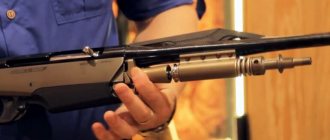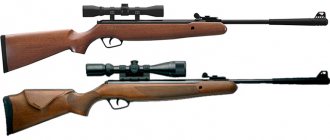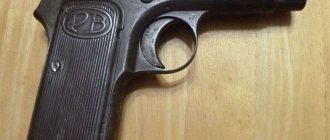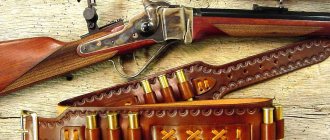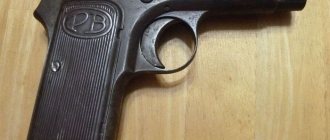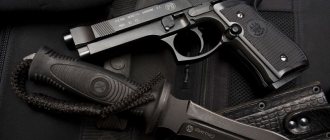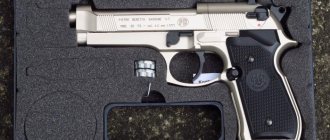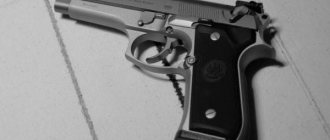The Stoeger-2000 hunting rifle was developed in 2000 by one of the Turkish arms companies, which was purchased by the famous Italian arms concern Beretta. The first modifications of the gun went on sale in 2001. This pump-action shotgun, which is a clone of one of the famous models of the Beretta company, turned out to be of high quality and reliable. One of the main advantages of this model is its affordable price. The Stoeger-2000 is available in various modifications and can perform many tasks, from hunting to self-defense.
Although at its core the Stoeger-2000 shotgun is a real Beretta, it differs from Italian models in both the quality of its finish and its affordable price. If you delve into the nuances, it turns out that the quality of the internal mechanisms of the Beretta and Stoeger-2000 shotguns is at the same level. The characteristics of the Turkish gun are reliable and have a large margin of safety. This weapon is universal and suitable for hunting any animal.
Stoeger 2000 modifications
As mentioned above, this gun is offered in several modifications, which allows each consumer to choose exactly the version of the gun that suits his tasks:
- The Stoeger 2000 Standart is a classic version of the Turkish shotgun, which is an excellent copy of the Italian Benelli M1 Super 90. The stock is made of plastic. The average price is 32 thousand rubles;
- The Stoeger 2000 Deluxe is a prestige version of the pump-action shotgun, has an engraving, and the stock is made of wood. The barrel is made of stainless steel. The kit includes several attachments based on Beretta Optima attachments. The average price is 39 thousand rubles;
- Stoeger 2000 Camo - the main feature of this modification is the camouflage coloring. This allows you to use a hunting shotgun unnoticed in the forest. The average price is 32 thousand rubles. Features are the same as the standard version;
- Stoeger 2000 Synthetic is the most prestigious version of the family. The shotgun is designed for true connoisseurs of style and design. The characteristics are standard, the average price is 46 thousand rubles.
Review of MTs-21-12
The MTs-21 hunting semi-automatic was developed in 1956; it was a basic model that is no longer produced. In 1960, the MTs-21-12 model appeared, which is still produced in several versions. This smooth-bore semi-automatic machine is still popular among hunters, both in our country and abroad. MTs-21-12 has a detachable barrel, the length of which is 750 millimeters. It is made of high quality alloy alloy and plated with chrome. There is an aiming bar on the barrel, on which you can install non-removable optics if necessary.
Caliber 12, chambered for a regular 70 mm cartridge
The design of the automatic operation is based on the principle of partial rollback of the barrel, according to the Browning system: a reliable and time-tested inertial system. The under-barrel magazine is made in the form of a tube and holds four cartridges, the fifth is sent into the chamber. The butt and fore-end are made of wood, such as birch, for regular execution and from valuable species for export and piece execution.
Apart from the usual, export and piece versions, the difference of which lies in the wood materials and the presence of skillful engraving on the cheeks of the receiver, the MTs-21-12 is available in several modifications: MTs-21-12P with a rubber pad on the end of the butt; MTs-2112MP with a rubber lining and replaceable muzzle attachments on the barrel.
Turkish arms manufacturers
The truth, as always, is somewhere in the middle. There is no independent and original school of gunsmiths in Turkey (and before the First World War, unlike many countries, the production of weapons was generally handicraft and piecemeal), therefore, mainly either “shooting sticks” or copies of European ones are produced (most often - Italian, less often French or American) samples. In total, about 180 brands of weapons are registered in Turkey. However, it is worth remembering that there are no more than 40 of them that deserve respect; the rest are handicraft family contracts that have never heard of technology, the purchase of high-quality steel, normal processing, they do not have product catalogs, etc. Therefore, when purchasing such types of weapons, firing triggers (trigger mechanisms) and serious breakdowns in the first 20-100 shots are not uncommon. Those who bought such Turkish guns are the ones who criticize their eastern neighbors.
However, the situation changes dramatically when it comes to major players in the arms market - such companies purchase high-quality Belgian steel, hire European craftsmen and try in every possible way to “catch up and surpass” their mentors. Moreover, the weapons they produce differ from European originals only in the external finishing of lower quality. So if you are interested in an inexpensive and high-quality self-loading gun for hunting, then you should take a closer look at Turkish catalogs.
The largest Turkish arms concerns include:
- Vursan (production of the Stoeger model),
- ATA Arms, in Russia known as the manufacturer of Companion E (also called Companion),
- Sarsilmas,
- Hatsan (Hatsan),
- Huglu,
- Khan Arms
But it is strongly not recommended to buy self-loading shotguns from these manufacturers:
- Impala (barrels are crooked, they can even break when shooting),
- EGE Silah (there are indecently many factory defects, although the characteristics of the weapon are not bad).
Part 1 - review
The choice of a smooth-bore hunting semi-automatic device, most often, comes down to the formula “gas outlet or inertia.” You can probably recall other systems with recoil of the barrel (Browning Auto 5-MC 21-12), but their share in sales, as it seems to me, is small. There are many pros and cons of supporters of the gas outlet and the inertial scheme; it is hardly worth going deeply into this topic now. Let me just say that many people are attracted to the inertial design due to the ease of weapon maintenance (disassembly and cleaning).
I was looking for a relatively inexpensive semi-automatic hunting rifle for feather hunting (primarily) and also faced the choice of an automatic system. Since the reliability of reloading for this kind of hunting is not a critical factor compared, for example, with hunting ungulates, the choice was made in favor of the inertial system. This does not mean that the “inertia” is unreliable. We are talking about hypothetical reliability arising from purely theoretical considerations. In practice, delay when firing a semi-automatic weapon can occur in any system and is more often dependent on the ammunition than on the gun. In this case, I reasoned like this: if a cartridge suddenly fails to supply, then the worst thing that can happen is that the duck will fly away. Unlike boar hunting, when a delay in shooting can cost the hunter much more. On the other hand, the inertia action is very convenient for cleaning and is as simple as possible (a little more complicated than a pump-action shotgun).
You can watch a video about Benelli inertial systems:
Of the inertial semi-automatic machines on the market, you have to choose from a large number of Italian models and a number of Turkish ones. Benelli is traditionally considered the “king” of inertia action guns, but the price starts at $2,000 in Moscow stores, which seemed to me excessive for a “working” gun. Moreover, I wanted to take the camouflage version of the finish, without artistic (or, if you like, pseudo-artistic) design.
But, nevertheless, I wanted to “join” the legendary Benelli technologies. The Beretta holding, which now includes Benelli, has several other brands that produce inertia. Actually Beretta ES100, Franchi (in a wide range) and Stoeger made in Turkey. The Beretta was rejected due to the fact that it is a relatively old model with a wedge-locking action and a spring in the stock. The price of this sample, although lower than Benelli, nevertheless, cannot be called budget.
A little brandy. The Stoeger company first appeared in the United States in 1920 and was founded by an Austrian emigrant as an importer of weapons from Europe. In the 1990s, it was acquired by the Finnish concern Sako, which was later purchased by the Beretta holding. Currently, the Turkish company Stoeger produces smooth-bore pump-action shotguns and semi-automatic rifles.
Stoeger 2000A CAMO
Franchi Affinity
Thus, the choice was between Franchi Affinity and the Turkish Stoeger 2000A. By comparing these two models, I came to the conclusion that they are structurally very similar and both are a clone of the Benelli M1 Super 90. The difference may be in the finishing (although the Franchi is not a masterpiece in this area, it is such a solid European “economy class” ), but the difference in price at the time of purchase was almost 1.5 times in favor of Turkey. In addition, the barrel of the Turkish gun, as sources say, was made in Italy at the same enterprise as Franchi. It is difficult to spoil all the other details, so the final choice was made in favor of the “Turk”.
What is inside?
As mentioned above, the Stoeger 2000A is a version of the Benelli M1 Super 90 system. Its features: a bolt with a rotating cylinder, locking on two lugs; a return spring located around the tubular magazine; two rods from the bolt to the spring. That's probably all. The system is really as simple as a rake.
Bolt and handle
Disassembly is even simpler - put the bolt in the rear position, remove the bolt handle (simply pull it out like a cork from a bottle), unscrew the tubular magazine cap, pull the forend along with the barrel out of the grooves, remove the return spring. All that remains is to remove the bolt along with the rods. It is interesting that the bolt simply lies on the figured cutouts of the rods and is not fastened to them in any way.
There are two important notes here. Firstly, the bolt handle is not secured to the bolt and can easily pop out when being carried.
And some users claim that yes, it is true - they lost it. So, stock up. True, they say handles from MP-153 are suitable. Secondly, it is very easy to lose the washers located under the annular boss of the barrel.
Washer
They prevent the magazine cap from unwinding itself. It’s difficult to find them - you need branded ones. They are irregularly shaped to prevent the plug from unscrewing itself.
Fuse
The safety is typically American, located on the trigger guard. This is pure taste - some like it this way, others like it on the neck of the butt. No worse and no better than each other.
The magazine cutter is on the bottom right of the receiver. Just a metal plate with a notch. The bolt stop release button simultaneously unlocks the cartridge feed tray from the magazine. The force on the button is very decent. Perhaps it will weaken over time.
The window for loading cartridges, as on all similar guns, is at the bottom of the receiver. I have no complaints about its size and shape - the cartridges fit quite comfortably, even at a fast pace of loading. The cartridge feed tray does not cover the entire loading window; moreover, under certain circumstances, it can “bite” the thumb if the hand is wearing a glove. What I didn’t like: the unclear mechanism for fixing the cartridge in the magazine. On the tube-magazine pump-action and semi-automatic shotguns I've handled, this process always ends with a distinct click of the magazine tooth engaging the base of the case. It’s as if the cartridge is “floating”.
The trigger guard and its base are plastic. Nowadays, such solutions on even higher-class hunting rifles are all too common. What do we want from the unfortunate “Turk”?
Sights - a rib and a red fiber optic front sight. In my opinion, the front sight is a bit thick. The manufacturer does not provide for the installation of any additional sighting devices on the receiver. Accessory suppliers can help.
I recently saw a Weaver rail that mounts on top of the receiver. Only the cotter pin that passes through the receiver is replaced with a longer one. True, you will have to come to terms with the fact that the camouflage gun will have a blued “blap” on top of the receiver.
A set of replacement chokes and a key for them
I took the modification with the longest barrel 760 mm, 5 interchangeable chokes and MAX-4 camouflage paint.
Chokes can be easily distinguished by the number of grooves (indicated by an arrow) from 1 (full choke) to 5 (cylinder).
The coating feels like a smooth matte material based on a synthetic film. I don't know how durable it will be in use. In a thrift store I saw a similar gun in MAX-4 paint with white bald spots. True, I can’t say anything about the intensity and nature of the operation of this specimen.
My gun is by no means compact, rather “Ded Mazai’s oar.” But it fits quite well in your hands, you feel it like a reliable piece of hardware. I would characterize the weight as average, not heavy, but not overly light. Compared to shotguns with barrels of similar length, there is a clear weight gain due to the plastic stock and the absence of “extra” parts. Comfortable and high quality butt plate.
Rubber butt pad
Finishing metal parts is not for perfectionists, just as much as is needed for technological purposes, no more and no less.
The bolt and receiver parts are coated with matte paint (hardly blued).
Test firing see here
Related article:
Force of inertia – Franchi Affinity synt Combo
Where can this gun be used?
The design of this weapon allows it to be used everywhere. Technical characteristics enable hunters to use the Stoeger 2000 when hunting birds and large animals.
Many years of experience show that the build quality of the gun allows it to be used in any weather conditions: with high humidity, extreme heat or severe frost. In all conditions, all mechanisms operate equally reliably and smoothly. The main moving mechanisms are coated with an anti-corrosion solution.
The variety of modifications of this hunting rifle allows it to be used for civil self-defense. The short barrel makes it more convenient and compact: the shotgun is quickly removed, you can aim faster and even shoot offhand.
Pros and cons of Stoeger
The main advantages of this hunting rifle include:
- High strength and large supply of working life;
- Possibility to use the weapon in any climatic conditions;
- Reasonable mid-range price;
- Easy to use and maintain.
On the other hand, users talk about the following disadvantages:
- Low quality of body finishing;
- You cannot use any ammunition.
Technically, the gun turned out to be remarkable, so the Turkish engineers decided not to bother with its appearance and quality of finish. In the forest, weapons quickly become covered with scratches. As a rule, after a year of active operation, the gun looks as if it had been fighting in a “hot spot” for 3 years. More or less, this flaw is masked by a modification of the camouflage color scheme.
General description of Stoeger-2000
The Stoeger-2000 hunting rifle appeared in Russia back in 2003, but is still in demand. Turkish weapons have long surpassed their Russian counterparts in terms of workmanship, while the price remains at a fairly acceptable level. Of course, they are still far from the build quality of German or Italian guns, but the mechanisms of Turkish guns work flawlessly, and you can hunt with these weapons without significant modifications.
Russian owners of Stoeger-2000 note the following advantages of their weapon:
- The weapon is extremely reliable;
- Very rarely breaks;
- Has many accessories for tuning;
- It is distinguished by its adaptability and good accuracy. The stock is comfortable for most hunters.
For lovers of beautiful weapons, there is the Stoeger-2000 “Deluxe” model, which is decorated with engraving and has a higher quality build. For lovers of a laconic appearance, there is a modification M-2000 “Synthetic”. This is an all-black gun with a stock and fore-end made of impact-resistant plastic. According to the manufacturer, the stock and forend of this model are completely scratch-resistant.
Description
The Stoeger 2000 shotgun is a prominent representative of smoothbore weapons, although the quality of finish is slightly inferior to more expensive products of the same brand. However, this does not mean at all that the manufacturer tried to save on working elements - the Stoeger weapon is an absolutely reliable and efficient design that operates well in various conditions.
On certain variations of this model, engravings and various accessories are applied to improve the external finish. One such example is the Stoeger 2000 Deluxe. Many users unanimously highlight the M 2000 synthetic variant, which is distinguished by its aesthetic appearance.
The Stoeger is made of black plastic material; the stock is not subject to external influences in the form of scratches, dents from falls, etc. All Stoeger parts look reliable, strong and of high quality. By the way, parts of guns of some Stoeger modifications are made of wood. To disguise possible scratches, wooden parts are painted camouflage. It is so real that during a hunt it gives invisibility against the background of greenery to elements that might get lost among the foliage.
The butt plate on the butt ends in rubber, which significantly reduces the discomfort of recoil that occurs when shooting from the Stoeger.
Stoeger 2000 Camo
The history of the appearance of Stoeger-2000 and the arms company Stoeger Silah Sanayi AS
The Stoeger-2000 hunting rifle was put into production in 2001 at the Stoeger Silah Sanayi AS plant. This Turkish plant was previously called Vursan arms, but after being purchased by the Italian concern Beretta, it was renamed.
The Stoeger-2000 is an inexpensive but high-quality weapon. It is suitable for both hunting and protecting life and property. The fighting qualities of Turkish guns are in no way inferior to Italian models, although the appearance and quality of finishing of Italian models are very different.
For some, the purchase of the Turkish Vursan arms plant by the Italian concern Beretta looks quite strange. It would seem, why produce inexpensive and high-quality weapons based on the popular Italian model, and sell them at a lower price? The fact is that any major arms company tries to occupy all price categories. There are no overtly cheap models in the Beretta line of hunting rifles, and the lowest price category remains unclosed.
Buyers who want a Beretta will buy themselves an expensive gun. Those hunters who cannot afford the Italian brand will take their money to another manufacturer who can offer hunting rifles with a modern design and a low price.
The Stoeger 2000 shotgun is a discontinued Beretta model called the 1201F. This model was atypical for Beretta, as it had an automatic operation system from Benelli. The buyer felt that there was no point in buying a Beretta with a Benelli assembly if he could buy a “purebred” Benelli gun. In addition, the installation of Benelli automatics on a Beretta gun was regarded as an indicator of the imperfection of Beretta automatics.
Beretta hastened to discontinue the model that discredited their prestige and began refining its automation systems. When the decision came to create a production of inexpensive hunting rifles under a different brand, the discontinued model turned out to be the ideal solution, which allowed us to release a high-quality model without tarnishing the Beretta name. This is how the Stoeger-2000 hunting rifle appeared, which immediately showed its superiority over domestic semi-automatic devices of a similar design.
Advantages and disadvantages of Stoeger
Unlike domestic semi-automatic devices of a similar design, reviews of Turkish Stoeger-2000 shotguns are mostly positive. Here is a list of the main advantages:
- Durable design and long working life, which significantly exceeds the life of domestic semi-automatic machines;
- The reliability of the design and high-quality chrome plating of the barrel bore and chamber allow this weapon to be used in any climatic conditions. At least that's what the manufacturer says;
- The price of the Stoeger-2000 is significantly higher than its domestic counterpart, but a gun with such technical characteristics should cost much more;
- Easy to disassemble/assemble.
Although the Stoeger-2000 has few disadvantages, some owners complain about the following nuances:
- The gun is not as indiscriminate in accepting ammunition of various price categories as the MP-155;
- The finishing of the body of the Turkish gun is frankly poor, although domestic semi-automatic devices look even worse.
Buying a Turkish semi-automatic machine is a profitable investment, while buying a domestic semi-automatic machine is a lottery. It often happens that more money is spent on modifications to Russian semi-automatic machines than was needed to purchase them.
The Beretta concern was able to offer potential buyers high-quality hunting weapons at a low price category. Thanks to this, since 2003, Russian hunters have been able to purchase high-quality semi-automatic weapons that do not require modification.
Operating principle of Stoeger-2000 mechanisms
Automation Stoeger-2000 works according to the following principle:
- At the moment of firing, the bolt of the weapon moves backward, while it pulls the edge of the return spring with it. For this purpose, special double-sided rods are used;
- During a shot, the bolt frame moves forward only 4 mm, after which its movement is blocked by the other mechanisms of the gun, which prevent the frame from moving further;
- The recoil energy causes the bolt carrier and bolt to move backward. At the same time, the return spring is compressed;
- When the compression of the return spring reaches its maximum, the entire mechanism of the gun returns to its original position.
Sources
- https://MilitaryArms.ru/oruzhie/vintovki/stoeger-2000/
- https://WarWays.ru/ognestrelnoe-oruzhie/vintovki-ruzhya-karabiny/stoedzher-2000.html
ATA Arms shotguns
The review of the best Turkish shotguns on the Russian market will be completed by an outstanding company in every sense - ATA Arms. Its founder, Chelal Yollu, who made the first hunting rifle at the age of 13, and opened a business at 23. ATA developed very quickly because its head found a middle ground between European quality and low price (for example, when advertising double-barreled shotguns, ATA spends 30-40 times less than European companies such as Beretta or Sauer). Moreover, ATA Arms was the first company on the Turkish market to release (albeit with the help of European technologies) its own double-barreled shotgun, first with horizontal barrels, and then vertical, inertial shotguns, etc.
The most popular and deservedly loved by hunters were the catalog models ATA Arms NEO (Neo) 12 gauge and ATA Arms CY (Companion).
Let's start, perhaps, with the Companion, which is in many ways an analogue of the Beretta A301. The operating principle of the Kompanion is a gas-operated semi-automatic with a return spring located in the butt. The caliber of the gun is 12/76 or 20/76. Barrel length is 51 or 76 cm. The magazine contains 5 rounds, plus one in the barrel. However, the main difference between the Companion is the extremely low declared weight (up to 3 kg with 12 gauge and up to 2.4 with 20). So if you are tired of the heaviness of products from domestic manufacturers, then Turkish smoothbore guns, and especially Companion, will appeal to you.
Among the minor features of the ATA Companion model, we can note the easy recess of the trigger, a special gas vent system (two easily replaceable gas vents are used, for firing from 24 grams to magnums).
It also has its drawbacks: the plastic trigger of the Companion can break when fired, and for every hundred shots fired from the Companion there are a couple of misses. Italian guns would be more reliable (since their owners rarely complain about any problems), but a 30-40% difference in price can brighten up the Turkish penchant for hackwork and determine the choice in favor of the Companion.
However, the ATA NEO series five-shot self-loading shotgun (12, 20 or 28 caliber) has no such shortcomings. Among the additional advantages, it is worth highlighting the ease of disassembly (a couple of movements are enough to remove and clean the barrel + trigger), possible execution in plastic, lightness and grip. Inertial shotguns in this series are reliable and have much less recoil than in automatic weapons based on gas-operated mechanics.
Among the shortcomings of Neo, produced by ATA, it is worth highlighting only the insufficient resistance of Turkish walnut to various climatic conditions (it quickly loses its luster if used as a hunting weapon and not a collectible weapon) and the extremely strange policy of ATA Arms in the field of supply of swivels (it is included in the kit, however There is no fastening for it. You can drill it out with a drill, but such “finishing with a file” leaves an unpleasant aftertaste).
Characteristics of ATA Neo:
- Shotgun caliber: 12, 20 or 28/76;
- Weight: from 2.7 (20 gauge) to 3.1 kg;
- Barrel length: 61, 66, 71, 76, 81 cm;
- Magazine capacity: 4+1.
ATA Arms also produces a line of pump-action shotguns in the Etro series.
Brief summary:
- Turkish guns, copying Italian guns, nevertheless add something of their own: elegant design, lightness, ease of cleaning and disassembly.
- Turkish guns are an order of magnitude cheaper than their foreign counterparts (usually 30-40%), while maintaining a significant share of the quality of their European predecessors.
- In total, there are about 180 brands of weapons, of which only about 40 are trustworthy. If you decide to buy weapons not from the list proposed at the beginning of the article (remember, Vursan, Hatsan, ATA Arms, Huglu, Sarsilmas), then choose Turkish guns from those manufacturers who have their own website and catalog, and when purchasing, fully inspect your a copy for curvature of trunks and other external defects.
- Many Turkish companies cooperate with large European arms holdings (Beretta, Stoeger, well-known Czech and French companies).
General conclusion
Both semi-automatic machines, the MTs-21-12 and the Stoeger-2000, are quite decent, that is, reliable, well-assembled, and work almost flawlessly, subject to the manufacturer’s instructions for use. The price difference is not too big. Suitable for both beginners and experienced hunters. The choice will likely come down to personal preference.
What do you think is better: Stoeger-2000 or MTs-21-12?
Previous entry Rules for transporting hunting weapons
Next entry Shotgun IZH 58
Hatsan shotgun
It should be noted that the Hatsan concern has been engaged not only in the production of smoothbore guns for 80 years. It also produces heavy weapons for tanks and infantry fighting vehicles, torpedoes, various types of small arms, etc.
In Russia, the most famous Hatsan product is the Escort series models of 12 and 20 calibers, namely the Hatsan Escort Trio - a semi-automatic gun with gas-operated automatics.
Let's look at the Hatsan Escort shotgun with a gas-operated machine gun and its features.
- All Hatsan models with wooden stocks come with butt pads with a Triopad system that allows you to adjust the size of the stock to suit your needs. True, butt pads for plastic stocks will have to be purchased separately.
- All Escort connections are made of special alloys that provide excellent corrosion resistance and are resistant to stress.
- Quick store emptying system.
- Cold forged barrels.
- Rapid magazine loading system patented by Hatsan. It allows you to reload the Escort with one hand without changing your body position.
- 5 replacement nozzles are included.
- Smart Valve Piston system, patented by Hatsan (“smart” gas outlet that allows you to load cartridges with different weights).
- The absence of complex components and mechanisms in the Escort model is ideal for lovers of “iron” weapons that do not need to be disassembled with a manual at hand.
- Excellent sharpness of the Hatsan Escort model (from a distance of 35 m, the shot enters a dry pine board to a depth of one and a half to two of its diameters).
Let's look at the Hatsan Escort Trio (specifications taken from the manufacturer's catalogs) in more detail, not counting the above-mentioned features of the Escort:
Characteristics of the Hatsan Escort Trio model:
- Shotgun caliber: 12/76, 20/76;
- Barrel length: 55, 61, 66, 71, 76 cm;
- The capacity of the basic magazine is 4+1, with the possibility of expanding to 7+1 or narrowing to 2+1;
- Weight: from 2.5 (20 gauge) to 3.3 kg;
- The butt and fore-end are plastic.
It should be noted that the Escort model from Hatsan has a lower weight compared to its domestic counterparts (3.3 versus 3.4-3.7), which makes it more convenient for hunting on the go and makes it easier to throw up and hold in the air. Therefore, the price for Hatsan will be higher.
The Escort series also produces pump-action and tactical shotguns.
Operating principle
The Stoeger shotgun operates using an inertial reloading system. The principle of operation is that under the influence of recoil force the inertial spring is compressed, the rotary face rotates and comes out of the hook, the bolt goes back (the return spring has compressed). During this, the sleeve is extracted. After this, the return spring begins to expand, pushing the bolt back. The bolt captures a new cartridge from the feeder and feeds it into the chamber. When the shutter takes its original position, the cylinder turns back and fits into the grooves. This is necessary so that the bore is securely locked.
The semi-automatic version of the Stoeger M3000 is not considered outstanding, but it makes an impression. Having looked at it and tested it in action, many are wondering why our gunsmiths prefer to develop models with the gas-operated principle of automation?
Everyone knows that automation, operating on the principle of recoil and recoil with a special buffer spring of the bolt, dampens recoil a little worse than automation, operating on the principle of gas exhaust, but it is simpler and does not show particular sensitivity to the types of powder charges. And for 12-gauge Magnum ammunition, a chamber length of 7.6 cm is not particularly needed. Considering the quality of the cartridges and the performance of their shot firing at a distance of forty-five to fifty meters, the benefit turns out to be quite dubious. It turns out that a semi-automatic product, operating on an inertial automatic principle and having a chamber 7 cm long, will be more in demand among Russian hunters.
Stoeger 3000 in Realtree colorway
Stoeger 2000 design
The basis for this weapon was the Italian Benelli M1 Super 90 shotgun. This is easy to understand if you compare the design of the two types of weapons. The inertial automatics with locking the barrel with a rotating bolt, the operation of the return spring and much more are identical here.
There is a spiral-shaped return spring, which is located in the forend and completely surrounds the under-barrel magazine. The automation operates on the basis of a mechanism connecting the return spring and the shutter.
The trigger in the Turkish shotgun was completely adopted from its Italian counterpart. It has good quality and reliability, so engineers from Turkey did not “reinvent the wheel a second time.” The USM is removable.
Shooting is carried out with one caliber of cartridges - twelfth. Magnum 12/76 cartridges are used for shooting. Different modifications of this gun offer different barrel lengths - from 470 to 760 millimeters.
It is unacceptable to use weak cartridges with this hunting rifle. Only powerful charges should be used. When using them, the recoil is enough to activate the automation. Experts recommend using cartridges with a 28-gram charge or higher. There are reviews on the Internet about good performance when using cartridges with a 24-gram charge, however, this is rarely possible and when using only expensive charges. It is permissible to use ammunition with a long cartridge case from 70 to 76 millimeters.
The sighting mechanism of the Stoeger 2000 is classic. The “Standard” version is equipped with a rib with a notch that prevents glare, and a round front sight. Some versions of this complex are produced only with a higher front sight. The stock is made of plastic or wood (depending on modification). The butt plate is covered with rubber, which significantly reduces discomfort from recoil during shooting.
